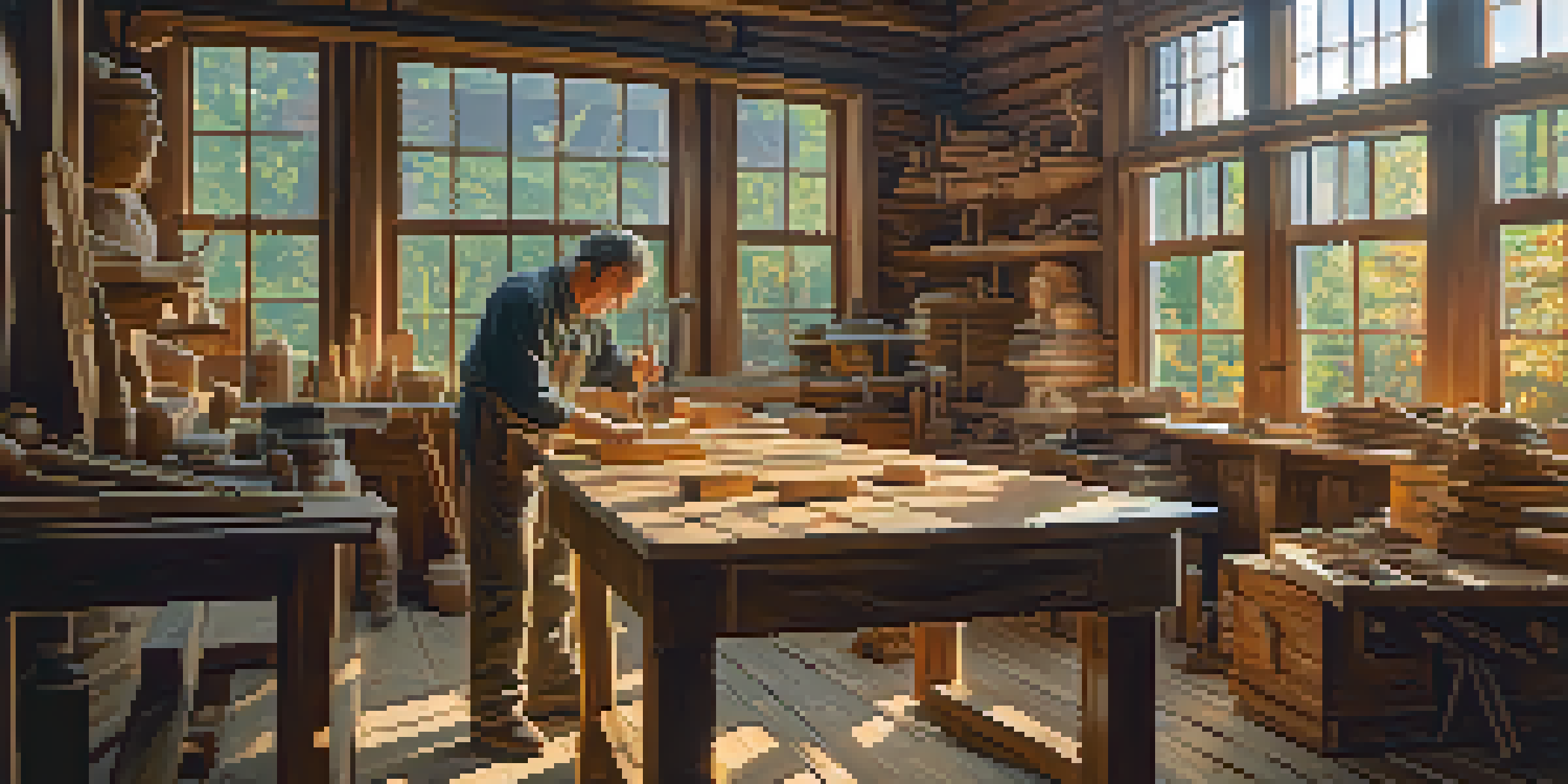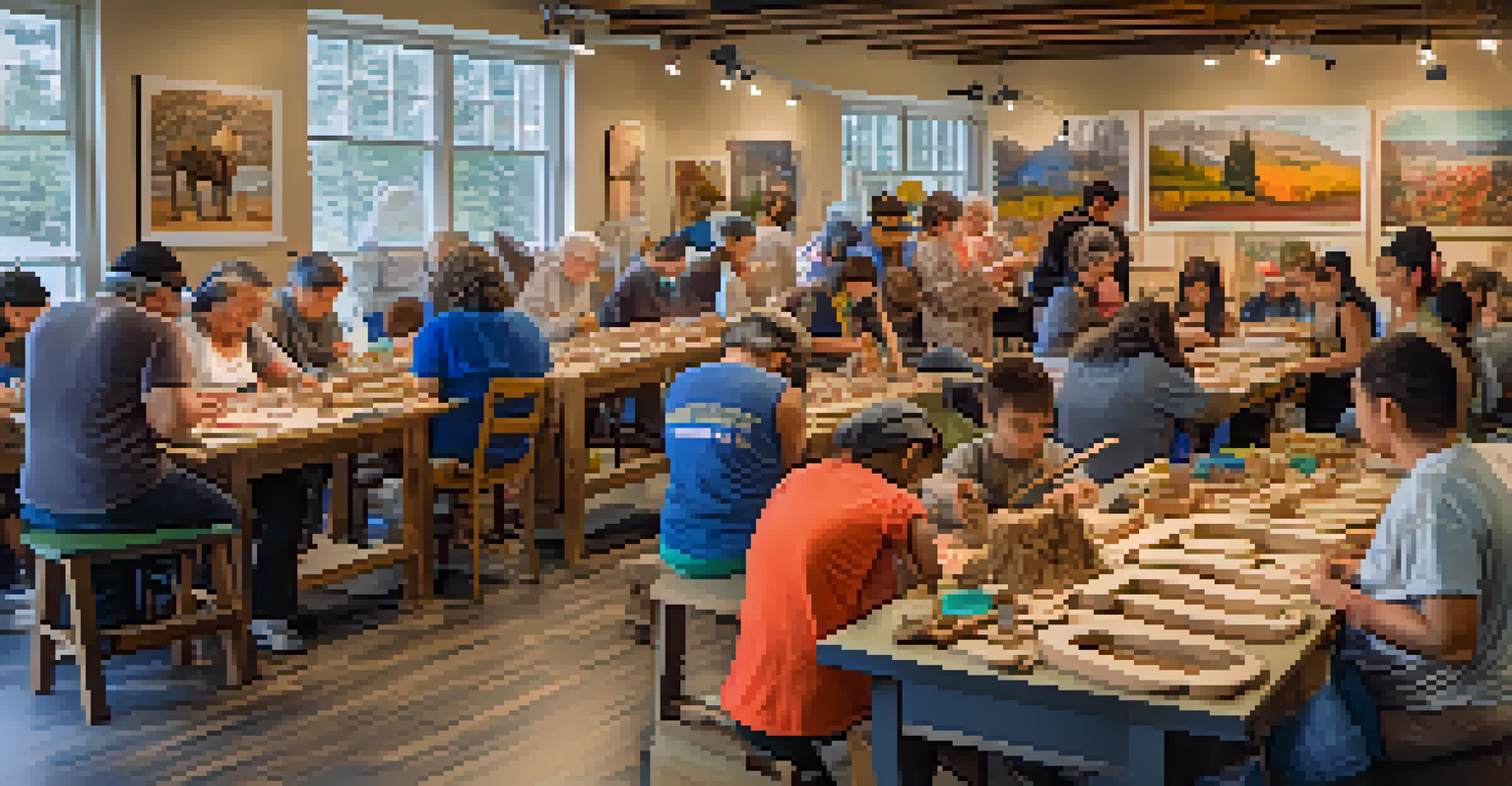Reviving Lost Arts: Modern Carving and Heritage

Understanding the Importance of Carving Traditions
Carving as an art form has deep roots in many cultures, often reflecting their history and beliefs. From intricate wooden sculptures to delicate stone carvings, each piece tells a story. These traditions, however, have faced decline due to modernization, leading to a loss of cultural identity in some communities.
Art is not freedom from discipline, but disciplined freedom.
Reviving these lost arts is crucial not just for preserving history but for fostering a sense of belonging. By learning these techniques, artisans connect with their ancestors and keep their stories alive. This cultural transmission enriches our collective human experience.
Moreover, the act of carving can be therapeutic, providing a creative outlet and a way to unwind. As modern society grapples with rapid changes, reconnecting with these ancient practices can offer solace and grounding.
The Evolution of Modern Carving Techniques
While traditional carving methods are invaluable, modern artists are integrating new tools and materials. This blend creates a unique fusion of old and new, resulting in innovative designs that appeal to contemporary audiences. For instance, digital carving machines can produce intricate patterns that would take hours to achieve by hand.

Artists today are also exploring diverse materials, from reclaimed wood to recycled plastics, aligning their craft with sustainability efforts. This shift not only reduces waste but also breathes new life into forgotten items. The creativity seen in modern carving can inspire a wider appreciation for the art form.
Reviving Carving Preserves Culture
Reviving traditional carving techniques is essential for maintaining cultural identity and fostering community connections.
Incorporating technology doesn’t diminish the skill of carving; instead, it enhances it. Artists can experiment and push boundaries while still paying homage to traditional techniques. This evolution is essential for keeping the craft relevant in a fast-paced world.
Community Workshops: Bridging Generations
Community workshops are pivotal in passing down carving skills to younger generations. These workshops foster an environment where knowledge is shared, allowing participants to learn directly from seasoned carvers. This hands-on experience not only builds skills but also strengthens community ties.
The only way to do great work is to love what you do.
In these sessions, participants often share stories and techniques, creating a sense of camaraderie. For many, it’s a chance to connect with their heritage and understand the significance of the craft. The joy of creating something tangible together can be a powerful bonding experience.
Moreover, community workshops can serve as a platform for cultural exchange, inviting diverse voices to share their carving traditions. This exchange enriches the learning experience and encourages a broader understanding of the art form's variations across different cultures.
Influence of Social Media on Carving Revival
Social media has become a powerful tool for artists to showcase their work and connect with audiences. Platforms like Instagram and TikTok allow carvers to share their processes, challenges, and achievements in real-time. This visibility helps demystify the art of carving and inspires others to try their hand at it.
Additionally, online communities can provide invaluable support and resources for aspiring carvers. Tutorials, live demonstrations, and feedback from experienced artists create an encouraging atmosphere for learning. This digital camaraderie can lead to the formation of new friendships centered around a shared passion for carving.
Modern Tools Enhance Traditional Art
The integration of modern tools and materials allows artists to innovate while respecting the craftsmanship of traditional carving.
The reach of social media also opens doors to global audiences, allowing traditional techniques to be appreciated worldwide. As more people discover these art forms online, there’s potential for revitalization and a renewed interest in local carving traditions. This momentum can help keep the craft alive for generations to come.
Celebrating Carving Through Exhibitions and Competitions
Exhibitions and competitions play a vital role in celebrating and promoting carving arts. They offer artists a stage to showcase their talents and creativity, drawing attention to their work. Events like these not only highlight individual artists but raise awareness about the importance of preserving carving traditions.
Participating in competitions can also motivate artisans to hone their skills and explore new ideas. The thrill of showcasing their work in front of judges and peers can drive innovation and push the boundaries of what’s possible in carving. Winners often gain recognition, opening doors to new opportunities and collaborations.
Moreover, exhibitions can educate the public about the rich history and significance of carving. By engaging visitors through interactive displays and workshops, these events foster appreciation for the craft. They serve as a reminder of the beauty and intricacy involved in carving, encouraging more people to participate in its revival.
The Role of Education in Carving Revival
Education is crucial for the revival of carving arts, as it provides the foundation for skill development. Schools and institutions that offer specialized programs can equip students with both traditional techniques and modern innovations. This structured learning can help preserve the craft for future generations.
Beyond formal education, mentorship programs can offer invaluable support for aspiring carvers. Pairing experienced artisans with novices creates a nurturing environment for skill-building and creative exploration. This one-on-one guidance can instill confidence and inspire a passion for carving.
Education Fuels Carving's Future
Educational programs and mentorships are crucial for nurturing the next generation of carvers and ensuring the art form's survival.
Additionally, integrating carving into broader art curricula can foster a deeper understanding and appreciation for this craft. By exposing students to the history and cultural significance of carving, educators can cultivate a new generation of artists committed to preserving and innovating the art form.
Future of Carving: A Blend of Tradition and Innovation
The future of carving looks promising as artists continue to blend traditional techniques with modern innovations. This fusion not only keeps the craft relevant but also encourages experimentation and creativity. As new materials and technologies emerge, carvers are finding unique ways to express their artistic vision.
Moreover, as awareness of sustainability grows, many artists are prioritizing eco-friendly practices in their work. This commitment not only helps the environment but also resonates with consumers who value sustainability. The shift toward responsible crafting can inspire a new wave of carving that honors the past while looking toward the future.

Ultimately, the revival of carving arts hinges on the passion and dedication of the artists involved. By fostering a supportive community and embracing innovation, the art of carving can continue to thrive, ensuring that its rich heritage remains alive for generations to come.